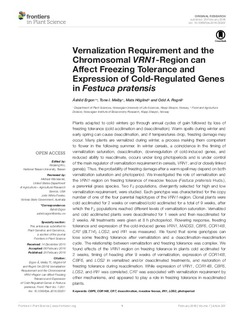| dc.description.abstract | Plants adapted to cold winters go through annual cycles of gain followed by loss of freezing tolerance (cold acclimation and deacclimation). Warm spells during winter and early spring can cause deacclimation, and if temperatures drop, freezing damage may occur. Many plants are vernalized during winter, a process making them competent to flower in the following summer. In winter cereals, a coincidence in the timing of vernalization saturation, deacclimation, downregulation of cold-induced genes, and reduced ability to reacclimate, occurs under long photoperiods and is under control of the main regulator of vernalization requirement in cereals, VRN1, and/or closely linked gene(s). Thus, the probability of freezing damage after a warm spell may depend on both vernalization saturation and photoperiod. We investigated the role of vernalization and the VRN1-region on freezing tolerance of meadow fescue (Festuca pratensis Huds.), a perennial grass species. Two F2 populations, divergently selected for high and low vernalization requirement, were studied. Each genotype was characterized for the copy number of one of the four parental haplotypes of the VRN1-region. Clonal plants were cold acclimated for 2 weeks or vernalized/cold acclimated for a total of 9 weeks, after which the F2 populations reached different levels of vernalization saturation. Vernalized and cold acclimated plants were deacclimated for 1 week and then reacclimated for 2 weeks. All treatments were given at 8 h photoperiod. Flowering response, freezing tolerance and expression of the cold-induced genes VRN1, MADS3, CBF6, COR14B, CR7 (BLT14), LOS2, and IRI1 was measured. We found that some genotypes can lose some freezing tolerance after vernalization and a deacclimation–reacclimation cycle. The relationship between vernalization and freezing tolerance was complex. We found effects of the VRN1-region on freezing tolerance in plants cold acclimated for 2 weeks, timing of heading after 9 weeks of vernalization, expression of COR14B, CBF6, and LOS2 in vernalized and/or deacclimated treatments, and restoration of freezing tolerance during reacclimation. While expression of VRN1, COR14B, CBF6, LOS2, and IRI1 was correlated, CR7 was associated with vernalization requirement by other mechanisms, and appeared to play a role in freezing tolerance in reacclimated plants. | nb_NO |

